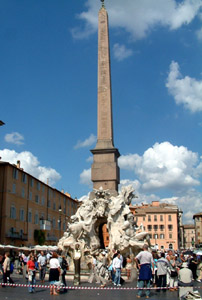
Piazza Navona
The Piazza Navona square in Rome is a favorite stop for both tourists and residents of the city.
The square was constructed at the former site of the Domitian stadium, where the ancient Agonal games were
held. The name Navona is believed to be derived from the term “in agone”, which refers to a place or site
where competitive games are held.  Today the area is still a hive of activity, with several outdoor cafes and numerous street vendors. As the largest square in the city of Rome, the Piazza Navona is host to three separate fountains and the famous Church of Sant'Agnese in Agone. The Story Of Sant'Agnese The legend associated with the Church of Sant'Agnese (Saint Agnes) involves a young girl who refused to marry one of her suitors. Agnese was a thirteen-year-old Christian girl who caught the eye of a young Roman boy. After she rejected him because he didn't share her faith, the Roman authorities took Agnese's clothes and forced her to stand nude in public. But as soon as they removed her clothing, her hair grew so quickly that it covered her exposed body. Agnese was tortured and eventually decapitated. Her skull was recovered and today rests in the Church of Sant'Agnese. Enjoy The Fountains  The largest fountain in the Piazza Navona is the Fontana de Quattro Fiumi, which translates to
'the fountain of the four rivers'. Construction of the fountain began in 1647 and was originally designed by
artist Francesco Borromini. Later the project was completed by the sculptor Giovanni Bernini. The fountain
contains four figures representing the Danube, Ganges, Nile, and Rio de la Plata Rivers. The largest fountain in the Piazza Navona is the Fontana de Quattro Fiumi, which translates to
'the fountain of the four rivers'. Construction of the fountain began in 1647 and was originally designed by
artist Francesco Borromini. Later the project was completed by the sculptor Giovanni Bernini. The fountain
contains four figures representing the Danube, Ganges, Nile, and Rio de la Plata Rivers.The other two fountains, the Fontana di Nettuno and the Fontana del Moro, were designed by artist and sculptor Giacomo della Porta. Although construction of the Fontana di Nettuno began in 1576, the project was not completed for three centuries. Initially, the fountain was referred to as Calderari, in reference to the local coppersmiths. Later, additional statues were added, including a sculpture of Neptune wrestling an octopus, flanked by a pair of sea nymphs. The Fontana del Moro was built in 1575. Like the Fontana di Nettuno, this also received additional embellishments. Bernini contributed a Moorish styled triton figure upon a dolphin. At the perimeter, other tritons were added, each blowing from a horn or shell, from which water flowed. The base of the fountain is constructed of a unique type of marble called portasanta, a red-colored limestone that's native to Italy. In 1874, the Fontana del Moro was refurbished and the original statues transferred to a fountain in Giardino del Lago. Today, the fountain exhibit at Piazza Navona contains replicas of the originals. Indulge Your Taste Buds... In addition to its sculpture, the Piazza Navona offers a number of cafes, eateries, and clubs. The Tre Scalini, one of the most popular restaurants in the area, is well known for its delicious tartufo, an ice cream specialty topped with cherries, chocolate, and whipped cream. Enjoying a tasty meal or mouthwatering snack at one of the square's cafes is a wonderful way to relax after a hectic day of sightseeing. |
Aeolian Islands Italy Travel Italy Trips Holidays to Italy Hotels in Italy Luxury Hotels Couch Surfing Walking Tour Bardolino Puglia Holidays Italy Photos Valley of the Temples 2 Valley of the Temples Rome Tourist Attractions Piazza Navona Trevi Fountain Rome Pictures Vatican Tour Holidays in Florence Tuscany Bicycle Tours Florence Photos Venice Tourist Attractions